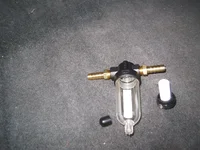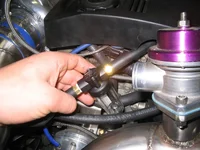You are using an out of date browser. It may not display this or other websites correctly.
You should upgrade or use an alternative browser.
You should upgrade or use an alternative browser.
Oil Catch Can
- Thread starter 02p5
- Start date
Little Beavis
Member
- :
- 2001 MP3-T (#911)
Yeah good question. . .
^bump^
^bump^
oil catch can - purpose is to "catch" any "blow by" oil from recircualting back into the system.
1) Reduces sludge buildup
2) Reduces the chances of detonation
1) Reduces sludge buildup
2) Reduces the chances of detonation
...basically adding "hot oil" into the intake runners and combustion chamber.... adds...well heat... more heat means increase POSSIBILITY for detonation....
therefore, less oil / no oil means....less POSSIBILITY for detonation
therefore, less oil / no oil means....less POSSIBILITY for detonation
it will keep your intercooler and pipes clean of film so they can keep doing their job efficiently. very little of the oil itself and heat associated with it (it has to pass through the turbo which will heat it up more) will actually make it to the combustion chamber. it will get caught on the intercooler and intake pipe mostly, decreasing efficiency. whether it's worth it, it depends on how much it costs.
Let me clarify, there are two things that you amy want to do in order to reduce the amount of oil entering the intake system.
1) The valve cover is vented back into the intake track of the turbo system (after the MAF) by a breather hose. Presumably this is to relieve any excess pressure without losing air that has already been metered. Because the engine usually has a bit of blow-by or frothy oil coming out of that hose though, over time your intake system will get coated in oil.
Installl one of these inline of the hose:

2) Adding a Catch Can to the PCV system. The PCV also is a source of oil re-entering the intake system. To be specific, the PCV system is there to vent crankcase pressure from "blowby" and other minor pressure fluctuations back into the intake plumbing. By adding a catch can to the equation...you again reduce the amount of oil and oil build up from entering the system.
So...yes oil directly entering into the intake manifold (not passing through the turbo) does directly affect the intake system.
or..
1) The valve cover is vented back into the intake track of the turbo system (after the MAF) by a breather hose. Presumably this is to relieve any excess pressure without losing air that has already been metered. Because the engine usually has a bit of blow-by or frothy oil coming out of that hose though, over time your intake system will get coated in oil.
Installl one of these inline of the hose:

2) Adding a Catch Can to the PCV system. The PCV also is a source of oil re-entering the intake system. To be specific, the PCV system is there to vent crankcase pressure from "blowby" and other minor pressure fluctuations back into the intake plumbing. By adding a catch can to the equation...you again reduce the amount of oil and oil build up from entering the system.
So...yes oil directly entering into the intake manifold (not passing through the turbo) does directly affect the intake system.
or..
Little Beavis
Member
- :
- 2001 MP3-T (#911)
Alright, so how would I do this then? Buy a catch can and plumb it to the PCV valve AND the breather?
YP5 Toronto said:Let me clarify, there are two things that you amy want to do in order to reduce the amount of oil entering the intake system.
1) The valve cover is vented back into the intake track of the turbo system (after the MAF) by a breather hose. Presumably this is to relieve any excess pressure without losing air that has already been metered. Because the engine usually has a bit of blow-by or frothy oil coming out of that hose though, over time your intake system will get coated in oil.
Installl one of these inline of the hose:

2) Adding a Catch Can to the PCV system. The PCV also is a source of oil re-entering the intake system. To be specific, the PCV system is there to vent crankcase pressure from "blowby" and other minor pressure fluctuations back into the intake plumbing. By adding a catch can to the equation...you again reduce the amount of oil and oil build up from entering the system.
So...yes oil directly entering into the intake manifold (not passing through the turbo) does directly affect the intake system.
or..
That's not a bad idea...I assume that fuel filter is air tight. Seems like a cheap alternative to a catch can.
Found some more info...
Both Naturally aspirated and turbo cars that run near redline are prone to venting excess oil and blowby out the valve cover. Manufactures vent this mist back into the intake manifold to be burned off in the combustion process. This is fine for street cars, however this oily residue on high performance N.A. cars and ESPECIALLY turbo cars will cause detonation, and gums up the intake tract, throttle body, and overall performance loss.
Both Naturally aspirated and turbo cars that run near redline are prone to venting excess oil and blowby out the valve cover. Manufactures vent this mist back into the intake manifold to be burned off in the combustion process. This is fine for street cars, however this oily residue on high performance N.A. cars and ESPECIALLY turbo cars will cause detonation, and gums up the intake tract, throttle body, and overall performance loss.
Little Beavis
Member
- :
- 2001 MP3-T (#911)
SO. . .
Does the catch can or filter attach to the "vent" on the cover or to the PCV valve? I'm feeling like a noob here. . .I don't know how to hook this up. . .I'd like to but I don't know if I fully understand this enough to mess with it on my own!
Does the catch can or filter attach to the "vent" on the cover or to the PCV valve? I'm feeling like a noob here. . .I don't know how to hook this up. . .I'd like to but I don't know if I fully understand this enough to mess with it on my own!
both...you can do both....
as both are ways that oil can enter into the intake system.
the valve cover is easy...take the exsisting hose....cut it in half...put the above mentioned filter in between...secure...and you are done.
as both are ways that oil can enter into the intake system.
the valve cover is easy...take the exsisting hose....cut it in half...put the above mentioned filter in between...secure...and you are done.
Most people will have the the pcv valve hose and valve cover breather hose feed into the catch can and the vapors are just vented to the atmosphere. Most catch cans will have holes in it to vent or a fitting for an air filter to vent. But beware the smog police venting to the atmosphere.
One problem with the above filter is if it ever gets full or clogged, you loose your vent for oil to drain from the cylinder head back to the oil pan and potentially cause an oil starvation under load. You might be suprised how quickly that little filter could fill up depending on how healthy your motor is.
One problem with the above filter is if it ever gets full or clogged, you loose your vent for oil to drain from the cylinder head back to the oil pan and potentially cause an oil starvation under load. You might be suprised how quickly that little filter could fill up depending on how healthy your motor is.
agreed....I have one one my car now....and with 2 months....don't see very much of anything.....maintanence is always the key. If you let such a visible filter get to a point in which it is not allowing the flow of gases...you have other problems. 
Little Beavis
Member
- :
- 2001 MP3-T (#911)
So, Cooch and YP5. . .are your recommendations to do this to both? And what kind of catch can do you recommend?
Do both...
For function and not much bling, http://www.jegs.com/cgi-bin/ncommerce3/ProductDisplay?prrfnbr=1781&prmenbr=361 , this is a very popular choice but it only has one inlet. You can add a fitting like this one, http://theoldone.com/components/breather/ . Ebay is a very good resource as well to get ideas. The moroso unit actually has baffles inside to assist in separating oil and most other's are just canisters with no baffles.
For function and not much bling, http://www.jegs.com/cgi-bin/ncommerce3/ProductDisplay?prrfnbr=1781&prmenbr=361 , this is a very popular choice but it only has one inlet. You can add a fitting like this one, http://theoldone.com/components/breather/ . Ebay is a very good resource as well to get ideas. The moroso unit actually has baffles inside to assist in separating oil and most other's are just canisters with no baffles.
Found out about this Air compressor filter, as a mini catch can from a srt4 owner at a meet saturday. It is nice and small, and has a clear container to see the oil, and a push button drain on the bottom.I removed the filter from it, seeing it would just obstruct the path of the oil/air.
I just reread this thread and read about putting the pcv valve into the catch can as weel. Im gonna go buy some hose this week, and remove the stock T for the PCV valve, and vent it into the catch can.
here is what it looks like.
I just reread this thread and read about putting the pcv valve into the catch can as weel. Im gonna go buy some hose this week, and remove the stock T for the PCV valve, and vent it into the catch can.
here is what it looks like.
Attachments
Little Beavis
Member
- :
- 2001 MP3-T (#911)
Where did you get it? How much? Part number?
Of course you can wait until you have "success" to share.
Of course you can wait until you have "success" to share.
Similar Threads and Articles
- Replies
- 9
- Views
- 2K
- Replies
- 0
- Views
- 426
New Posts and Comments
- Replies
- 56
- Views
- 3K
- Question
- Replies
- 1
- Views
- 125
- Replies
- 0
- Views
- 36
- Replies
- 3
- Views
- 221


